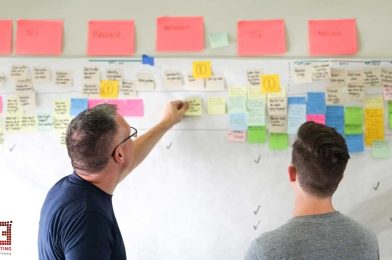In the field of consulting focused on process improvement and customer experience, some projects become true catalysts for internal change. Beyond solving specific operational issues, they enable organizations to transform the way they engage with customers, their internal structure, and their service culture.
Below, we explain a project developed by the Consulting C3 team, the specialized unit in operational and customer experience consulting at MST Holding. The project involved supporting an industrial organization, operating in the B2B services field, in the reorganization of its operational model and its customer relationship approach.
At the heart of this type of initiative lies the application of the service blueprinting methodology—a detailed map that allows organizations to visualize and systematically structure all internal flows linked to service delivery, from a clearly customer-oriented perspective. The value of blueprinting does not only lie in systematically documenting what already happens, but also in enabling the redesign, reorganization, and optimization of everything necessary to improve the quality delivered—and, above all, the quality perceived by the customer.
The Challenge: Fragmented Structures and Lack of Cross-Functional Vision
The client organization had a solid operational framework regarding the technical delivery of its services, but its internal functioning was heavily compartmentalized. Each area worked efficiently within its own scope, yet lacked a global vision of the complete process. This compartmentalized structure generated informal management dynamics that, while functional on a daily basis, hindered systematic service tracking and, above all, prevented the capitalization of lessons learned and improvements.
Moreover, there was no clear model articulating the complete customer journey, nor shared mechanisms to identify, anticipate, and manage critical points along the process. The lack of traceability—both in the relational dimension and in operational execution—significantly limited the ability to anticipate, complicated effective feedback, and conditioned the consistency of the customer experience.
In short, although the organization met its commitments with clients, it did so from a structure that neither facilitated relational efficiency nor continuous improvement. And in a B2B environment, where trust, coordination, and personalization are key factors, this represented a barrier to advancing toward a more robust and competitive service model.
The Approach: Blueprinting as an Analysis and Design Tool
The applied methodology made it possible to represent, in a visual, detailed, and shared way, the set of internal processes and relationships, aligning them with the different moments of customer interaction. This holistic view helped clearly identify where disconnections, information losses, unnecessary overlaps, or mismatches between internal actions and actual customer needs or expectations occurred.
The analysis phase drew on multiple sources of internal information: interviews with department heads, collaborative workshops, document reviews, and direct observation of workflows. All of this made it possible to create an accurate picture of the organization’s real functioning, beyond formal organizational charts or standardized procedures.
This “relational mapping” established a common ground among teams and areas that, until then, had only partial views of the full process. Putting on the table a shared service representation—from the customer’s perspective—was the first major step toward a more collaborative culture oriented toward the value delivered at every interaction.
Designing a Functional and Flexible Model
One of the key objectives of the project was to establish a functional framework that, without imposing rigidity or unnecessary bureaucracy, would provide greater control over operational and relational performance. To achieve this, a flexible structure was designed—adaptable to different situations, products, and customer profiles, but with consistent criteria of quality, traceability, monitoring, and measurement.
The model considered different levels of intervention depending on the type of customer, the service life cycle, and the complexity of the proposed solution. In addition, it incorporated mechanisms to facilitate cross-departmental coordination, the documentation of incidents and lessons learned, and the generation of useful information for strategic decision-making.
Another relevant aspect was that the designed blueprint was not conceived as a closed element, but as a living tool, able to evolve over time. Continuous improvement mechanisms and periodic review processes were integrated, allowing adjustments based on the experience gained during deployment and on feedback from both customers and internal teams.
Results: Greater Clarity and Organizational Alignment
Among the most noteworthy achievements of the project were:
- Improved internal visibility of key processes, enabling more informed decision-making.
- Clear definition of relevant customer service moments, with a special focus on those that shape quality perception.
- Formalization of control points that make it possible to detect and correct deviations without relying solely on individual proactivity.
- Creation of useful tools for internal training, facilitating the onboarding of new profiles and ensuring organizational knowledge transfer.
In addition, the project generated a very positive transversal effect: it fostered internal conversations that placed the customer at the center of organizational design. This awareness was key to strengthening the company’s relational focus, transcending departmental boundaries, and consolidating a shared vision centered on the value delivered to the customer.
Structural Collaboration and Strategic Vision
No improvement project can move forward without the active involvement of teams and the firm support of management. In this case, the combination of both factors allowed not only for procedure review but also the initiation of a deeper transformation: the kind that occurs when people understand that their work directly and unequivocally impacts customer experience and loyalty.
Mapping, measuring, and organizing are not bureaucratic actions. They are strategic decisions that strengthen internal coherence, improve coordination, and project outward an image of professionalism, commitment, and care—qualities that customers, especially in B2B environments, value deeply and consistently.
Because when an organization conveys that every stage of the service has been thought out, organized, and executed from the end-user’s perspective, the bond that is created goes beyond functionality. It builds trust. And trust is, ultimately, the best indicator of a successful blueprinting process.
At Consulting C3, MST Holding’s specialized unit, we work precisely to activate these kinds of transformations: structured, collaborative, and result-oriented, where the customer experience becomes the driving force of organizational change.

